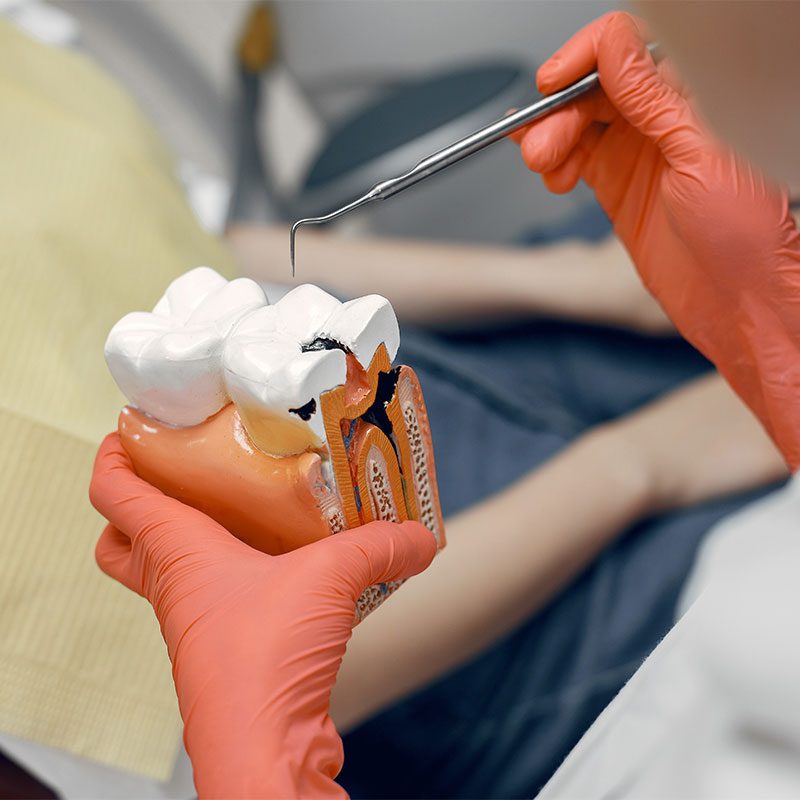What is cavity/ dental caries?
A cavity is a hole or area of tooth decay that forms in the hard surface of your teeth due to tooth decay. Tooth decay occurs when plaque, a sticky film of bacteria, combines with sugars and starches from food to produce acids that can erode the enamel—the hard, outer layer of the tooth. Over time, if not addressed, this erosion can progress deeper into the tooth, eventually reaching the softer dentin layer beneath the enamel and causing the formation of a cavity. Cavities can lead to serious toothaches, infections, and tooth loss.
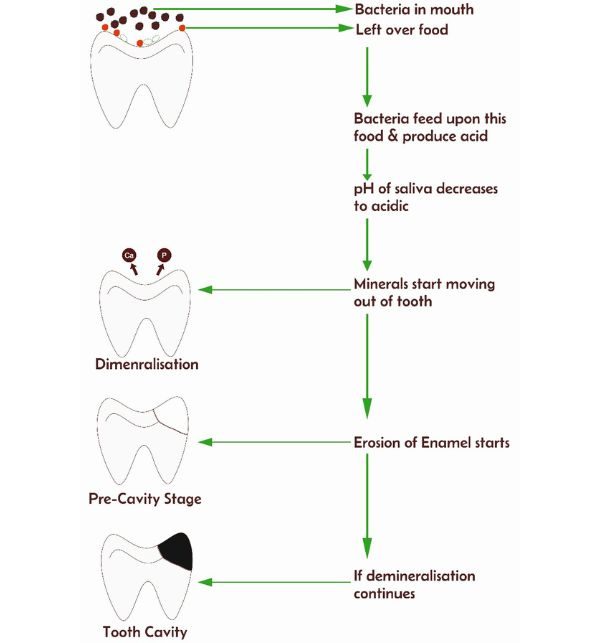
Cavity forming process
- Bacteria in your mouth feed on sugary, starchy foods and drinks (fruit, candy, bread, cereal, sodas, juice and milk).
- The bacteria convert these carbohydrates into acids.
- Ph. of saliva decreases due to the acids.
- The minerals (Ca++ and PO4-) start moving out of teeth in acidic media causing demineralisation.
- Demineralisation damages tooth enamel causing pre-cavity lesions and cavity.
- Enamel can repair itself by using minerals from saliva, and fluoride from toothpaste or other sources.
- However, if the tooth decay process continues, more minerals are lost.
- Over time, the enamel is weakened and destroyed, forming a cavity.
- Bacteria, acid, food and saliva mix to form dental plaque.
- This sticky substance coats your teeth.
- Without proper brushing and flossing, the plaque keeps on depositing over the tooth surface causing gum problems.
What is Demineralisation?
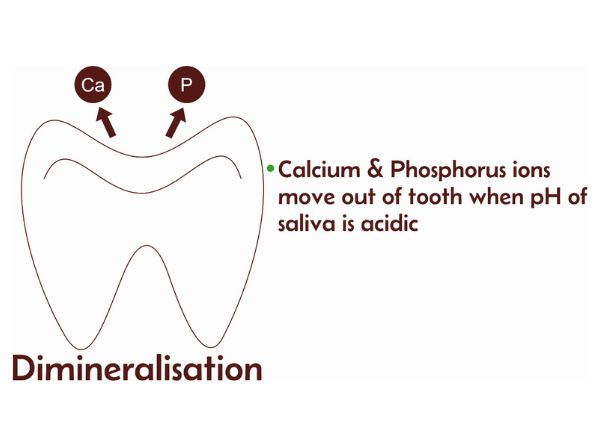
What is Remineralisation?
Teeth remineralisation is the natural process by which minerals, such as calcium and phosphate, are deposited back into the enamel of the teeth, restoring its strength and integrity. This process can occur when the pH level in the mouth is neutral or slightly alkaline, allowing minerals to be drawn back into the enamel from saliva and other sources. Remineralisation helps to repair early stages of tooth decay and can reverse the damage caused by demineralization if caught early enough. Fluoride and Xylitol found in toothpaste and some drinking water, can enhance the remineralisation process by attracting minerals to the tooth surface and making the enamel more resistant to acid erosion. Additionally, maintaining a balanced diet low in sugars and acids and practicing good oral hygiene can support the remineralisation of teeth.
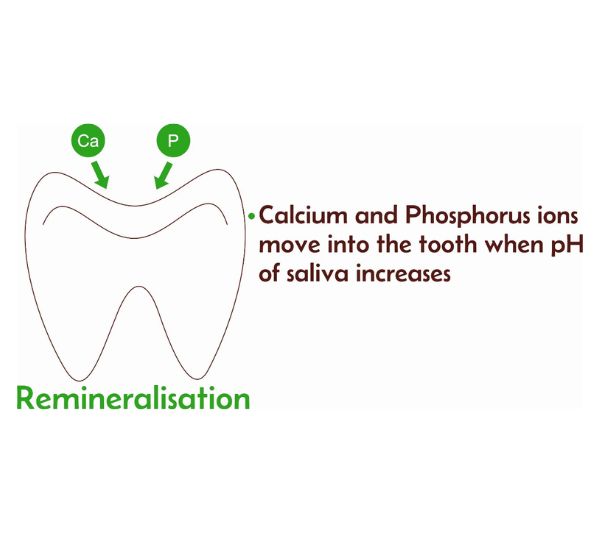
Cavity forming process
- Bacteria in your mouth feed on sugary, starchy foods and drinks (fruit, candy, bread, cereal, sodas, juice and milk).
- The bacteria convert these carbohydrates into acids.
- Ph. of saliva decreases due to the acids.
- The minerals (Ca++ and PO4-) start moving out of teeth in acidic media causing demineralisation.
- Demineralisation damages tooth enamel causing pre-cavity lesions and cavity.
- Enamel can repair itself by using minerals from saliva, and fluoride from toothpaste or other sources.
- However, if the tooth decay process continues, more minerals are lost.
- Over time, the enamel is weakened and destroyed, forming a cavity.
- Bacteria, acid, food and saliva mix to form dental plaque.
- This sticky substance coats your teeth.
- Without proper brushing and flossing, the plaque keeps on depositing over the tooth surface causing gum problems.
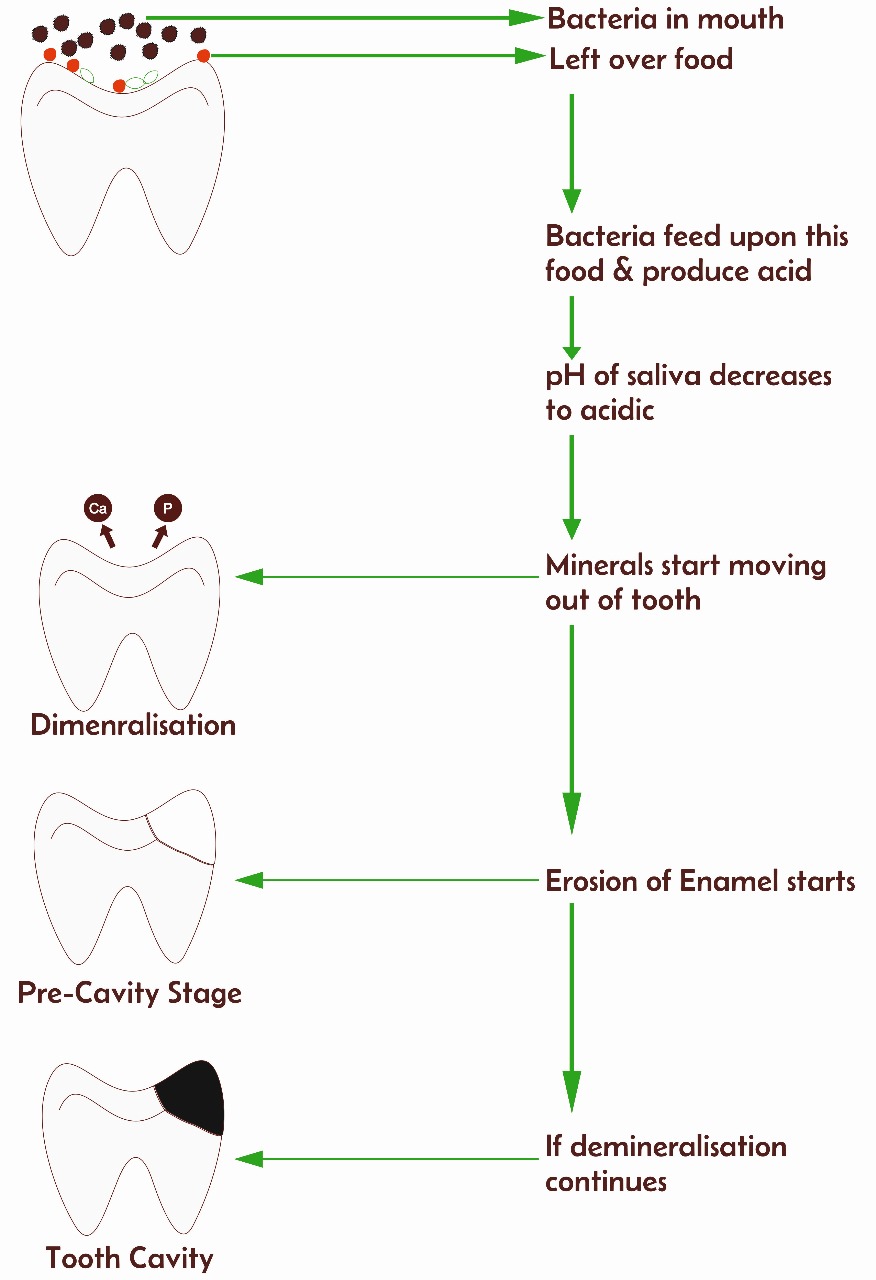
What is Demineralisation?
Teeth demineralization is a process where the minerals (such as calcium and phosphate) in the tooth enamel are lost, leading to the weakening and eventual breakdown of the enamel. This process is often caused by acids produced by bacteria in the mouth, usually as a result of consuming sugary or acidic foods and beverages. Demineralization can eventually lead to tooth decay or cavities if left untreated. It’s important to maintain good oral hygiene, including regular brushing and flossing, as well as visiting the dentist for check-ups, to prevent demineralization and maintain strong, healthy teeth.
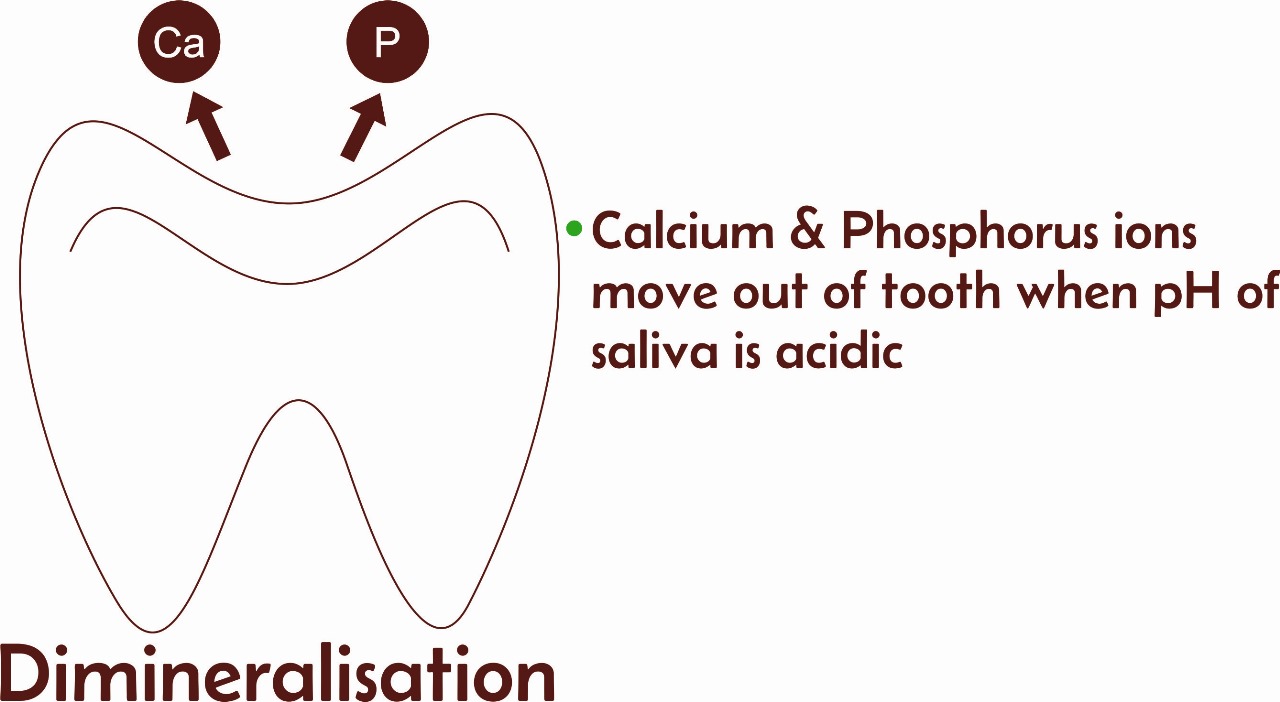
What is Remineralisation?
Teeth remineralisation is the natural process by which minerals, such as calcium and phosphate, are deposited back into the enamel of the teeth, restoring its strength and integrity. This process can occur when the pH level in the mouth is neutral or slightly alkaline, allowing minerals to be drawn back into the enamel from saliva and other sources. Remineralisation helps to repair early stages of tooth decay and can reverse the damage caused by demineralization if caught early enough. Fluoride and Xylitol found in toothpaste and some drinking water, can enhance the remineralisation process by attracting minerals to the tooth surface and making the enamel more resistant to acid erosion. Additionally, maintaining a balanced diet low in sugars and acids and practicing good oral hygiene can support the remineralisation of teeth.
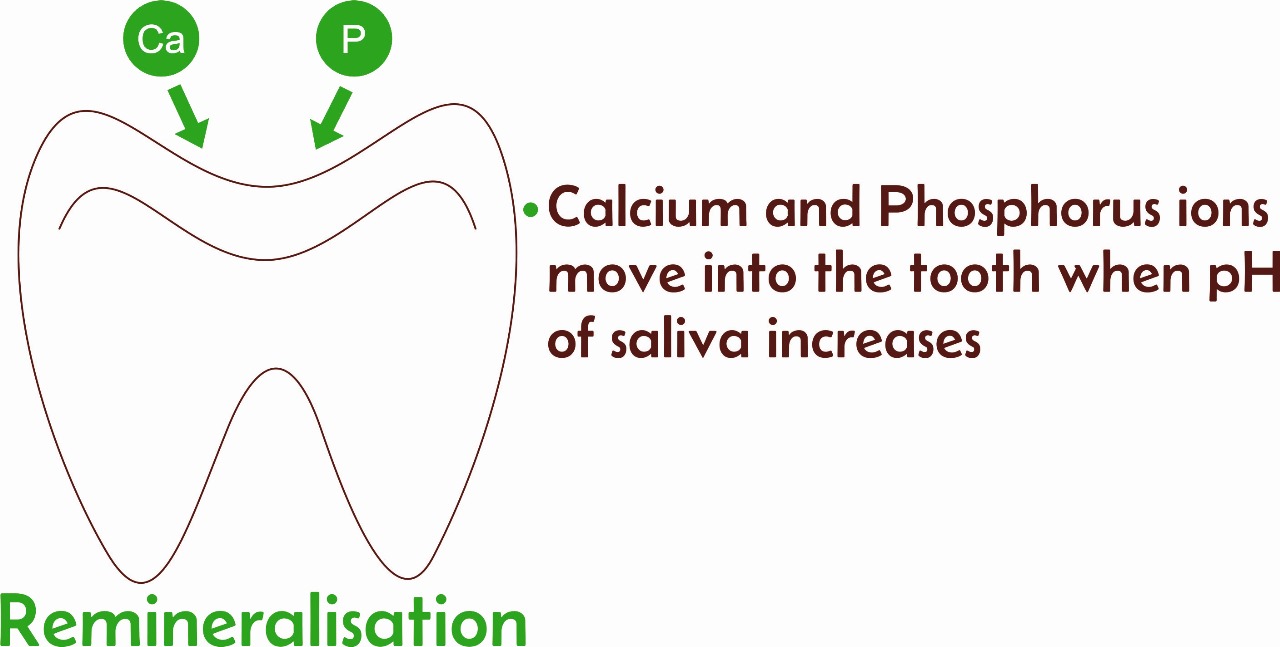
What is Plaque?
Plaque is a sticky, colourless film of bacteria that constantly forms on the teeth and along the gum line. It’s composed of bacteria, their by-products, food particles, and saliva. If not removed regularly through brushing and flossing, plaque can harden into tartar (also known as calculus), which is more difficult to remove and can lead to gum disease and tooth decay.
Plaque build-up on the teeth can irritate the gums, leading to inflammation and gingivitis, the earliest stage of gum disease. If left untreated, gingivitis can progress to periodontitis, a more severe form of gum disease that can cause irreversible damage to the gums, bone, and other structures supporting the teeth.
Regular brushing, flossing, and professional dental cleanings are essential for removing plaque and preventing oral health problems associated with its build-up.
How common are cavities?
According to NCBI, the overall prevalence of dental caries in India is 54.16%, with a 62% prevalence in patients over 18 years old Cavities are one of the most common chronic diseases affecting people of all ages.
According to the World Health Organization (WHO), more than 95% of adults in India have dental caries. According to government statistics, dental caries affects over 70% of school children and more than 90% of adults suffering from periodontal disease.
The main causes of cavities include:
1. Bacteria: Mouth contains various bacteria, some of which are harmful and can contribute to tooth decay. Bacteria feed on sugars and carbohydrates from food particles left on the teeth and produce acids. These acids can erode the tooth enamel.
2. Plaque: Plaque is a sticky film of bacteria, food particles, and saliva that forms on the teeth. If plaque is not removed through regular brushing and flossing, it can harden into tartar (or dental calculus), which provides a rough surface for more plaque accumulation and increases the risk of cavities.
3. Sugary and Acidic Foods: Consuming foods and beverages high in sugars and acids can fuel bacterial growth and contribute to tooth decay. Sugary snacks, candies, sodas, fruit juices, and acidic foods can all increase the acidity in the mouth and weaken tooth enamel over time.
4. Poor Oral Hygiene: Inadequate brushing and flossing allow plaque to accumulate on the teeth, increasing the risk of cavities. Without proper oral hygiene practices, plaque can build up, leading to enamel erosion and cavity formation.
5. Dry Mouth: Saliva plays a crucial role in protecting the teeth by neutralizing acids and washing away food particles and bacteria. Conditions that reduce saliva production, such as dry mouth (xerostomia), medications, certain medical treatments, and medical conditions, can increase the risk of cavities.
6. Genetics: Genetic factors can influence an individual’s susceptibility to cavities. Some people may inherit characteristics that make their tooth enamel more prone to decay or have a higher risk of developing certain dental conditions that contribute to cavities.
7. Environmental Factors: Factors such as socioeconomic status, access to dental care, and community water fluoridation can impact the prevalence of cavities in populations. Individuals with limited access to dental services or fluoridated water may be at higher risk for cavities.
How to Prevent Cavities?
1. Brush your teeth twice a day: Use fluoride and xylitol toothpaste with a soft-bristled toothbrush to thoroughly clean all tooth surfaces, including along the gum line and the back teeth. Brushing removes plaque, which is a sticky film of bacteria that can lead to cavities.
2. Floss daily: Flossing helps remove plaque and food particles from between the teeth and along the gum line, where a toothbrush may not reach effectively. Flossing once a day helps prevent cavities and gum disease.
3. Limit sugary and acidic foods and beverages: Sugary and acidic foods and drinks can contribute to tooth decay by feeding bacteria in the mouth and weakening tooth enamel. Limit consumption of sugary snacks, candies, sodas, and acidic fruits or juices, and try to consume them with meals rather than as snacks throughout the day.
4. Drink water: Drinking water helps rinse away food particles and neutralize acids in the mouth. It’s especially important to drink water after consuming sugary or acidic foods and beverages.
5. Chew sugar-free gum: Chewing sugar-free gum, especially one containing xylitol, can stimulate saliva production, which helps neutralize acids in the mouth and remineralize tooth enamel.
6. Visit your dentist regularly: Regular dental check-ups and cleanings are essential for maintaining good oral health. Your dentist can detect cavities early, provide professional cleanings to remove plaque and tartar, and offer personalized advice for preventing cavities.
7. Use fluoride and xylitol products: Fluoride and xylitol help strengthen tooth enamel and make it more resistant to decay. Use fluoride and xylitol toothpaste and consider using a xylitol mouthwash or receiving fluoride treatments from your dentist if you’re at high risk for cavities.
By incorporating these preventive measures into your daily routine and lifestyle habits, you can significantly reduce your risk of developing cavities and other dental problems. Remember that maintaining good oral health is essential for overall well-being.
FAQs of Cavities
A cavity, also known as dental caries or tooth decay, is a small hole or hollow area that forms on the surface of a tooth due to the erosion of tooth enamel by acids produced by bacteria in plaque.
How does Xylitol acts on cavities (caries)
Contact Us
Customer support
+91-9310022929
care@bhoojaa.com
Our location
A-12 1st floor, Prashant Vihar, Rohini Delhi-110085

